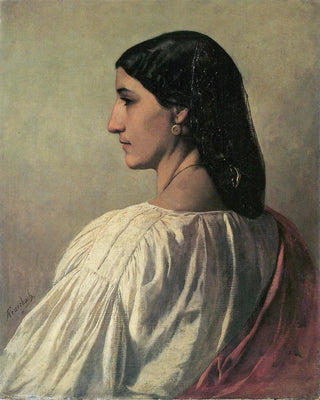Art print | Nanna - Anselm Feuerbach


View from behind

Frame (optional)
Nanna - Anselm Feuerbach – Captivating Introduction
The artwork "Nanna" by Anselm Feuerbach is a masterpiece that transcends the simple frame of painting to immerse the viewer in a universe of beauty and mystery. This painting, depicting a feminine figure imbued with grace and depth, invites attentive contemplation. The way Feuerbach captures the essence of his subject is both fascinating and moving, revealing an artistic sensitivity that still resonates today. Through "Nanna," the artist offers us not only a visual representation but also an emotional experience that evokes reflections on femininity and timeless beauty.
Style and uniqueness of the artwork
Feuerbach's style is distinguished by a harmonious fusion of romanticism and classicism, where the expression of feelings is combined with refined technique. In "Nanna," the color palette chosen by the artist creates an intimate atmosphere, where warm tones and delicate shadows highlight the delicacy of the subject. Every brushstroke seems charged with poetic intent, making the composition both dynamic and serene. Nanna's posture, at once majestic and vulnerable, demonstrates an exceptional mastery of the human form, while the treatment of drapery evokes fluidity and sensuality that captivate the eye. This work stands out for its ability to evoke deep emotions while remaining rooted in a classical aesthetic.
The artist and his influence
Anselm Feuerbach, an emblematic figure of the 19th century, knew how to blend tradition and modernity in his work. Raised in an artistic environment, he was influenced by Renaissance masters but also by the innovative ideas of his time. Feuerbach sought to reinterpret classical themes through a personal lens, which allowed him to forge a unique style. His approach to painting, focused on the expression of emotions and idealized beauty, inspired many contemporary and later artists. Through works like "Nanna," Feuerbach left an indelible mark on art history, bearing witness to an era where the pursuit of beauty and

Matte finish

View from behind

Frame (optional)
Nanna - Anselm Feuerbach – Captivating Introduction
The artwork "Nanna" by Anselm Feuerbach is a masterpiece that transcends the simple frame of painting to immerse the viewer in a universe of beauty and mystery. This painting, depicting a feminine figure imbued with grace and depth, invites attentive contemplation. The way Feuerbach captures the essence of his subject is both fascinating and moving, revealing an artistic sensitivity that still resonates today. Through "Nanna," the artist offers us not only a visual representation but also an emotional experience that evokes reflections on femininity and timeless beauty.
Style and uniqueness of the artwork
Feuerbach's style is distinguished by a harmonious fusion of romanticism and classicism, where the expression of feelings is combined with refined technique. In "Nanna," the color palette chosen by the artist creates an intimate atmosphere, where warm tones and delicate shadows highlight the delicacy of the subject. Every brushstroke seems charged with poetic intent, making the composition both dynamic and serene. Nanna's posture, at once majestic and vulnerable, demonstrates an exceptional mastery of the human form, while the treatment of drapery evokes fluidity and sensuality that captivate the eye. This work stands out for its ability to evoke deep emotions while remaining rooted in a classical aesthetic.
The artist and his influence
Anselm Feuerbach, an emblematic figure of the 19th century, knew how to blend tradition and modernity in his work. Raised in an artistic environment, he was influenced by Renaissance masters but also by the innovative ideas of his time. Feuerbach sought to reinterpret classical themes through a personal lens, which allowed him to forge a unique style. His approach to painting, focused on the expression of emotions and idealized beauty, inspired many contemporary and later artists. Through works like "Nanna," Feuerbach left an indelible mark on art history, bearing witness to an era where the pursuit of beauty and






